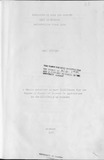| dc.description.abstract | In this study an attempt is made to investigate the marketing systems for poultry and eggs in the Mombasa Metropolitan Urban area.
The study focuses its attention mainly on two aspects of the poultry industry. First, it attempts to analyse the structure of the retailing systems for poultry and eggs. Second, the cost structure of the retailing systems has been investigated in an endeavour to reveal the operating price and marketing margins*
The study is based on primary data obtained by intervening poultry and egg retailers, hotels and other institutional consumers located in the Mombasa area, The survey was carried out during the period 8/12/77 to
15/2/78.
Questionnaires were used to obtain data. Secondary data have been used whenever they have been available and found to be relevant. Analysis of data has been done by cross-tabulations.
The results show first, that Mombasa urban area is the major market for exotic poultry and eggs produced from the adjoining districts of Mombasa, Kilifi and-Kwale These district.a supply more then 70 and GO per rent of th<
tot .1 monthly supplies of poultry and eggs respectively. Machakos and ‘Kitui districts predominate in the supply of indigenous poultry . -while MAT is becoming an import supplier of capons Second, the retailing systems are cl by a high concentration and inequality,
indicating lack of competitiveness in the trade
Third, the larger and wall established poultry farmers have none poultry and the major outlets for poultry and eggs
A smaller market share is therefore left to the numerous farmers having small poultry units. Fourth, in egg marketing, the middlemen ’ s remunerations constitute a large proportion of the total marketing margin, resulting in high consumer prices. The producers do not benefit from such high consumer prices. Fifth, there is recurrent
shortage of eggs especially during the period from October to March which is often characterised by high demand, for eggs.
It has therefore been concluded, first, that the
up
present poultry and egg marketing systems tend to favour the large and we.11 established poultry producers and nay therefore hinder expansion of poultry and egg production from the small scale farms. Two, there is lack of competition in the retailing systems with the result that collusive practices among middlemen are likely to occur. Three, seasonal fluctuations in demand for eggs are not well balanced with supply suggesting that either the current levels of egg production are low and cannot satisfy the market or that the distributive infrastructure is far from functioning smoothly.
Re-organisation of the marketing systems through co-operative movement nay help streamline the marketing of poultry and eggs from smaller units. The prominence of the middlemen may also he reduced, thereby increasing remunerations to tho farmers and excating incentives for an expended output. | |

